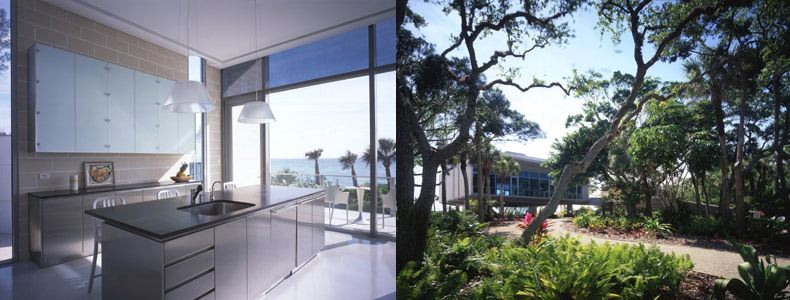1981年Toshiko Mori在紐約建立了Toshiko Mori建築師事務所。
Toshiko Mori從那以後研究許多不同的項目,從陳列設計,在佛羅里達、緬因、紐約和以色列的住宅、
在緬因的博物館項目,和在紐約、緬因, 和佐治亞的協會項目。
具體的發展範圍是為建築使用不同的材料和製造方法,和在經常使用新式和傳統建築的材料和技術與光和風景綜合化。
| Location | Buffalo, NY |
| Owner | Martin House Restoration Corporation |
| Program | Visitor Center |
| Size | 15,000 sqf. |
The Visitor Center will provide support spaces for visitors to the Darwin D. Martin House, Frank Lloyd Wright’s residential complex in Buffalo, New York, which is undergoing restoration. Programs housed in the Visitor Center include exhibition space, permanent galleries, a theater, and museum shop. TMA’s design seeks to enhance the Martin House through contrast rather than imitation. The Visitor Center reinterprets the Martin House to expose the structural, infrastructural, and programmatic relationships of the historic building, while continuing Wright’s lifelong interest in innovation through the exploration of new materials, technologies, and techniques. The inverted hip roof of the Visitor Center, for example, both references the form of Wright’s building and allows uninterrupted viewing of the Martin House. The glass façade of the Visitor Center reflects the public nature of the building’s program and contrasts with the introversion of Wright’s design.
訪客中心為訪客將提供支援的空間給馬汀複合住宅,Frank Lloyd Wright在紐約水牛城的複合住宅接受恢復。
在訪客中心安置的機能包括陳列空間、永久畫廊、一個劇院和博物館商店。
TMA的設計尋求通過對比來提升馬汀複合住宅而不是模仿。
訪客中心在創作上重新解釋馬汀複合住宅歷史建築的結構,基礎建設和綱領性關係,延續Wright終身對新的材料的探索和技術。
例如,參考被倒置的四坡屋頂Wright的大廈的形式和允許馬汀複合住宅的不間斷的觀察。
訪客中心的玻璃反射構建程序的公開本質并且與Wright的設計形成對比。








| Location | Syracuse, NY |
| Owner | Syracuse Center of Excellence |
| Program | Offices, Classrooms and Materials Testing Laboratories |
| Size | 80,000 sqf. |
The building’s proposed form and landscape are intended as a green urban intervention which will serve as an anchor to the connective corridor between downtown Syracuse and Syracuse University. The new facility will provide laboratory, classroom, and office space for the Syracuse Center of Excellence. Counter to a traditional introverted research lab, the Center of Excellence laboratories open themselves up to the surrounding city.
建物的提出的形式和風景意欲,因為將對連通性走廊在街市西勒鳩斯和西勒鳩斯大學之間的綠色都市干預。
新的設施為西勒鳩斯中心將提供實驗室、教室和辦公室空間。
與傳統相反的研究實驗室,由實驗室的中心打開自己周圍的城市。



| 墨西哥灣住宅 I |
| 佛羅里達Casey Key 1999 |
| Location | Casey Key, FL |
| Owner | Private Residence |
| Program | Residential Addition to Modernist Residence |
| Size | 2,800 sqf. |
The guest house to a 1957 house designed by Paul Rudolph is on a 535-foot wide sand bar near Sarasota Florida.
The Gulf of Mexico is to the west, Sarasota Bay to the East.
The Gulf side is a protected sea turtle habitat; the bay side a protected manatee habitat.
The house is built on the footprint of a structure destroyed by a hurricane.
The densely planted site is exposed to extreme climatic conditions - hurricanes, floods, downpours, and strong sun.
To protect the house from hurricanes, storm surges and flooding, the house is raised seventeen feet above sea level.
Sheltered by live oaks, palms and mangroves, it is reached by an exterior stainless steel staircase.
The stair becomes the new "center" of the house to connect and separate activities within.
對Paul Rudolph設計的房子在Sarasota Florida附近535英尺寬的沙洲。
從墨西哥灣西部,到Sarasota海灣東方。
海灣邊是一個被保護的海龜棲所; 海灣邊一個被保護的海牛棲所。
房子在颶風毀壞的結構的基礎建造。
建築點被密集地暴露在極端氣候情況-颶風、洪水、暴雨和強日。
要保護房子免受颶風,風暴浪湧和水淹,房子被上升海平面十七英尺之上。
由小橡樹、棕櫚和美洲紅樹庇護,它由一個外部不鏽鋼的樓梯到達。
臺階成為新的「連接中心和活動分離」的房子內。
Photographs © Paul Warchol





| 墨西哥灣住宅增建 I |
| 佛羅里達Casey Key 2005 |
| Location | Casey Key, FL |
| Owner | Private Residence |
| Program | Residential Addition |
| Size | 2,000 sqf. |
An addition to a residence designed by Paul Rudolph in 1957, the project is located on a narrow sand bar south of Sarasota, Florida. The compound consists of the original house on the southern end of the property and a guest house, also designed by Toshiko Mori Architect, to the north. The Addition is tucked into the southeast corner of the property and runs parallel to Sarasota Bay. The addition is attached to the existing residence only by a thin translucent canopy that creates a breezeway between the original house and the addition. The ground floor of the addition houses a kitchen and a large dining area that opens up to the pool area. A Master bedroom, bath, and an open terrace are located on the second floor.
對Paul Rudolph設計的住所加建,位於Sarasota Florida狹窄的沙洲南部。
增建在Toshiko Mori建築師設計的建物的南部的末端包括原本的房子到北部。
從原本的東南角落,平行延伸到Sarasota海灣。
在現有的住所創造一個在原本的房子和增建之間的一個稀薄的透亮機蓋。
一樓安置一個廚房和對游泳池周圍開放的大飯廳。
位於二樓有一個主臥室、衛浴和一個開放大陽臺。
Photographs © Paul Warchol




| 墨西哥灣住宅 II |
| 佛羅里達Casey Key 2002 |
| Location | Casey Key, FL |
| Owner | Private Residence |
| Program | Residential New Construction |
| Size | 10,400 sqf. |
The compound occupies a narrow strip of land near Sarasota, Florida, with borders on two bodies of water, Little Sarasota Bay to the east the Gulf of Mexico to the west. An old coast guard station was located there, and the dormitories and a large dock still remained. The site stretches east-west, dividing into a series of precincts that create a series of intimate, changing landscapes as one moves from gulf to bay. On the gulf side, the coast guard dormitory was remade into a guest cottage. The building sits on grade, and enjoys an intimate beach view, amid wild seagrass and seagrapes and sandy groundcover. The main house sits in the middle precinct, on tall piers to withstand extreme climatic conditions, enveloped in a tropical woodland landscape. The building commands long-distance views in both east and west directions, and hovers over the ground, touching down only at the glass-enclosed vestibule and at the termination of a ramp that stretches toward the bay. Along the bay’s edge, a low citrus grove grid abuts the pool house, pool and terrace, which forms its own geometric shape.
建物領地在Sarasota Florida附近一個窄條邊界,Sarasota海灣東部到墨西哥灣西部。
在那裡找出得到一個舊海岸警衛站,并且宿舍和一個大船塢仍然保留。
建築點展開的東西方,劃分成一系列親密的界域,從海灣移動到一个海灣作為改變的風景。
在海灣邊,海岸警衛宿舍被重建成了客莊。
建物享受一個親密的海灘視圖。
主要房子坐在中間界域,在碼頭承受極端氣候的情況,被包圍在一個熱帶森林風景地帶。
建物長向座落在東部和西部方向,并且盤旋在地面,著陸在玻璃旁的前庭和在延展到海灣終止。
沿海灣的邊緣,一個低柑橘樹叢柵格緊靠房子、水池和大陽臺,形成它自己的幾何形狀。
Photographs © Paul Warchol




 資料來源:
資料來源:
http://www.tmarch.com/
http://www.next-gene20.com/


























